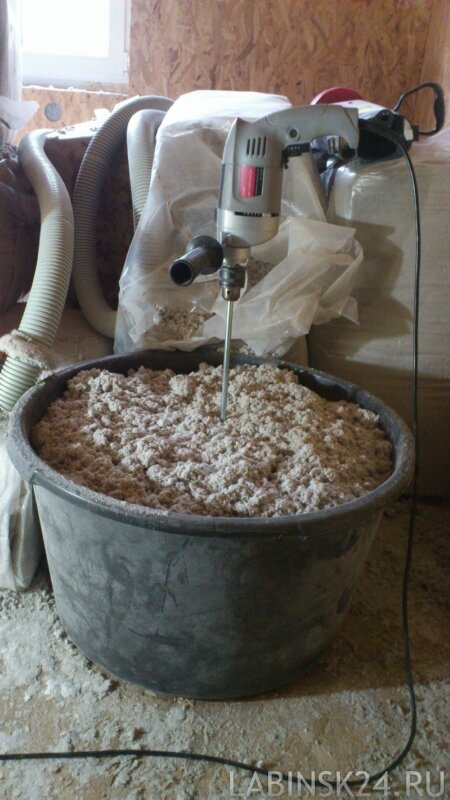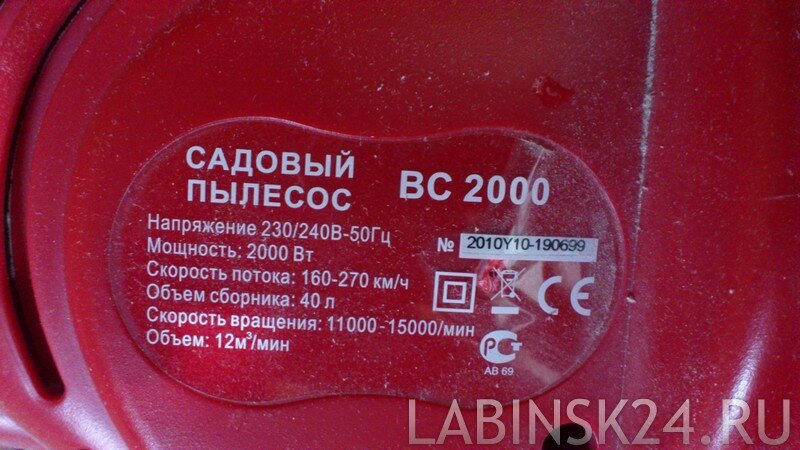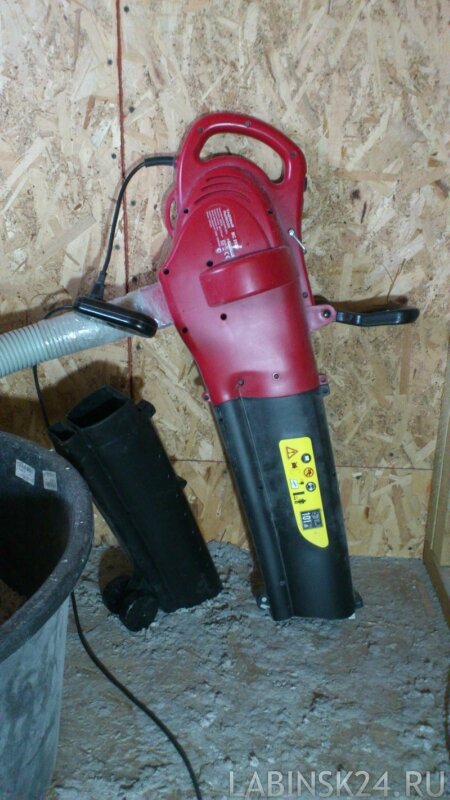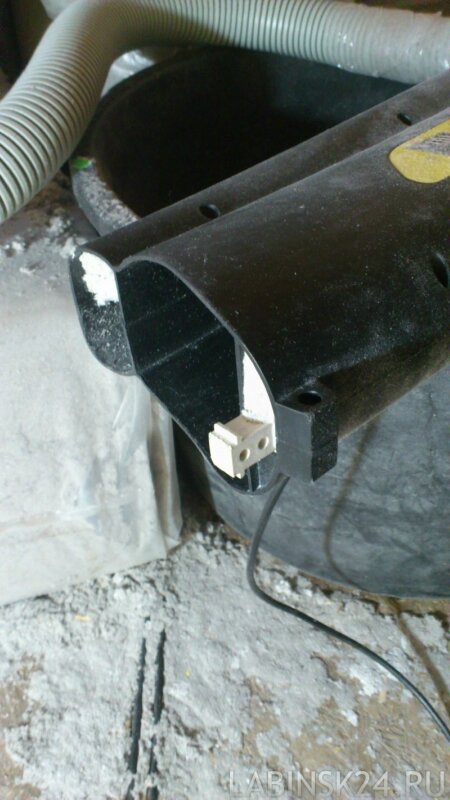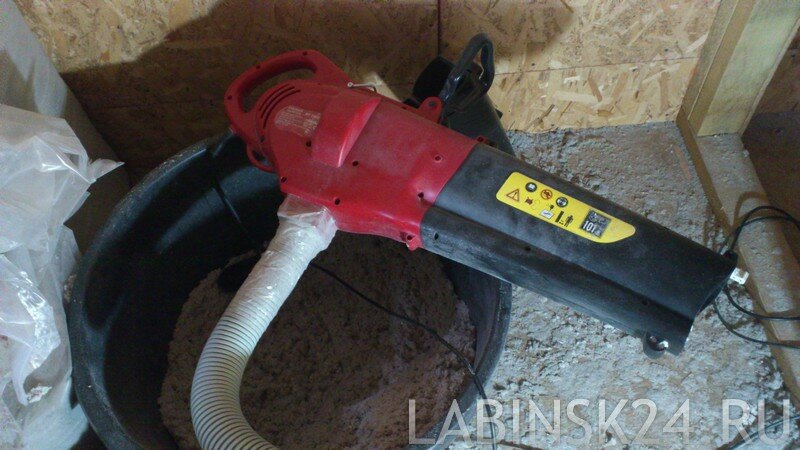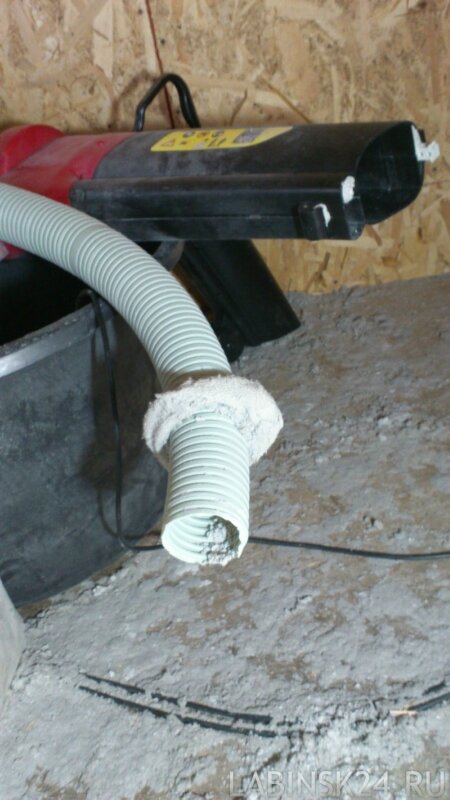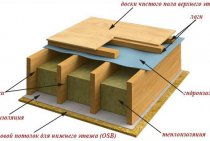How to cover the walls with ecowool without help
In order for the house to be comfortable both in winter and in summer, it must be properly insulated. There are many modern heaters and one of them is ecowool.
This insulation consists of approximately 80% recycled waste paper, the rest is flame retardants and antiseptics.
Do-it-yourself installation of ecowool can be done using a special machine or manually.
Advantages and disadvantages of insulation
Before you decide to apply ecowool, you need to familiarize yourself with the advantages and disadvantages of this material.
- high sound and thermal insulation characteristics;
- material is blown without seams;
- allows you to control the humidity in the house;
- environmentally friendly and non-combustible material;
- not damaged by mold and rodents.
But this insulation also has some disadvantages that must be considered before its application is performed:
Rice. 1 Appearance of ecowool
it is inconvenient to insulate the walls, since it is necessary to make a vertical backfill;
The process of blowing insulation Ecowool.
- We pour Ecowool into our construction trough, somewhere up to half.
- We stir it well with a drill with a mixer nozzle, Ecowool rises to the edges of the trough.
- We insert the corrugation into the hole in the wall so that it does not touch the bottom by 30 centimeters. To do this, you need to immediately measure the desired size on the corrugation and glue the electrical tape there as a mark so that you can not measure it every time.
- We seal the gaps between the hole in the wall and the corrugation, for example, with a fingerless glove already on the corrugation and one person holds the corrugation on the goffers.
- We turn on the blower at 3-4 speeds and suck in a little Ecowool, this is done by the second person, i.e. blowing is carried out by 2 people.
- By the sound and intensity of suction, we understand that Ecowool is already higher than the hose in the wall. We stop the vacuum cleaner and the man on the goats pulls the hose half a meter, seal it with a glove and blow it out again. This is done until the hose is almost completely pulled out. The last stage, when we insert the hose only 1 cm. and seal Ecowool until it stops.
We close the holes in the wall.
After blowing out the walls, the round pieces from the OBP that remained from the hole for the corrugation, we attach to the square pieces of oilcloth with a stapler, apply to the hole and fasten this oilcloth with a stapler already to the wall.
How to install ecowool - using ecowool applicators
Ecowool can be applied manually. But more often and more profitable to use special blowing machines for wet or dry spraying of ecowool.
This reduces the consumption of ecowool by 2 times. In addition, the manual method of installing ecowool will require much 20 (!) Times more time. A blowing machine for spraying ecowool allows you to apply ecowool to the desired surfaces without prior cutting and fitting to standard dimensions of the structure, just like foam is applied.
At the same time, the ecowool applied by the machine penetrates into all corners and openings, filling the insulated space completely and seamlessly.
Dry spraying is used in horizontal or sloping structures, such as top, bottom and intermediate ceilings. Wet spraying is used in vertical structures. In this case, moistened ecowool is applied to the surface (including open structures).
After drying, ecowool adheres well to adjoining structures, which eliminates settling and cracking of the insulation layer.
Such “adhesive” properties of wet ecowool are provided by the substance “lignin”, which is contained in cellulose and is activated when ecowool is wet.
Blowing machines are supplied for dry spraying of ecowool. For example, the blowing plant shown in the photo has the following parameters:
Productivity up to 15 kg (half a cubic meter) kevat per minute.
Power 2200 watts, powered by 220 volts.
The average resource is 10000 kg of ecowool.
Weight 15 kg., Dimensions 200 liter barrels.
For wet application of ecowool, an additional kit for wet spraying of ecowool is used (see photo).
The kit includes a powerful pump, a high pressure hose and a barrel with nozzles. In this kit, the sprayed material is wetted with water, as a result of which the ecowool is applied to the surface already wet. As already mentioned, this is necessary for mounting ecowool on vertical or inclined surfaces.
What layer of ecowool should be applied? - the thickness of the ecowool layer for warming floors, interfloor and attic floors (at an average air temperature in winter - 23C) is recommended at 20 cm with an ecowool density of 30-35 kg / m3.
The density of the material during wet spraying is somewhat higher - 35-42 kg/m3.
Calculations and experience show that these 20 cm of ecowool replace a layer of expanded clay with a thickness of 80-85 cm. Obviously, as a result, the load on the supporting structures of the building is significantly reduced.
Closed cavities, attics and inclined surfaces are insulated by dry blowing. The density of the material with this method of thermal insulation is 45 kg/m3.
Walls, layered masonry (well) are filled with insulation with a density of 52-55 kg / m3, which is achieved with the help of special nozzles for blowing installations using X-FLOC technology, which allow performing insulation work with maximum efficiency.
Another useful feature of installing ecowool.
After laying ecowool (dry or wet), after a few weeks, a thin papery crust forms on its surface (recall that ecowool is a cellulose material).
This is a consequence of the activation of the natural substance lignin under the influence of air humidity. This papery crust prevents the free circulation of air through the layer, which further improves the thermal performance of ecowool.
To speed up the formation of such a useful crust, it is recommended to slightly moisten the surface with a household spray gun.
How can I buy Ecowool insulation?
Find out the prices for our equipment - see Ecowool prices. Equipment
How do-it-yourself ecowool is made equipment and blowing ecowool
Ecowool is one of the varieties of heat-insulating materials. This is a cellulose insulation, which consists of an antiseptic and recycled cellulose. Cellulose fibers make up almost 80% of the material itself. It creates an excellent homogeneous seamless layer of insulation. What is ecowool insulation, reviews about it - we will talk about this in our article.
Ecowool definition. Its benefits
Ecowool consists of fibers that contain lignin in their composition - a substance that imparts stickiness when moistened. This material is completely harmless and absolutely non-toxic.
In addition, all its components are non-volatile, which means that they cannot harm the environment and people.
There are other benefits as well:
- good heat-insulating and sound-proofing material;
- not subject to decay and fungus;
- in the event of a fire, for a long time does not give in to fire;
- trouble-free installation;
It should be noted that in ecowool, as in all thermal insulation materials, rodents appear, which consider it as their food.
In its composition, this material contains substances such as boric acid and borax. It is they who reduce the fire hazard and provide good protection against fungi and decay. The low cost of cotton wool is associated with simple installation and inexpensive raw materials from which it is made.
Ecowool with your own hands. Laying methods
Ecowool can be laid by both professionals and amateurs. There are such laying methods:
Do-it-yourself blowing ecowool confronts a person with certain problems. This method is used to warm the floor and flows. Do-it-yourself ecowool is easy to fit, special equipment is not required here, as well as special skills.
Manual installation includes several steps.
First you need to prepare the insulation by pouring it into a container such as a bucket or basin. The next stage - "fluffing", is carried out using a drill.
Do-it-yourself ecowool blowing requires direct manual installation, which consists in filling it into the ceiling. But there are situations in which additional blowing equipment is required. After filling the insulation, it must be closed. To do this, you can use sheet materials, such as plywood.
With the mechanized method of laying, a technique specially designed for this is used. And wet-glue processing is usually done by professionals.
It is the last method that is the best.
Having considered what do-it-yourself ecowool is, the equipment that is used in this process is also worth considering:
- blowing installation - necessary for uniform supply of insulation;
- corrugated hoses - serve ecowool to the place of insulation;
- pump set;
- special nozzles for blowing.
This equipment is necessary when it comes to mechanized building insulation.
Do-it-yourself warming recommendations
With the help of ecowool, you can independently insulate the walls. floors, ceilings, attic floors and roofs. On construction sites, you can find out more specifically what ecowool insulation is, reviews about this process and recommendations.
But we will give some basic recommendations in our article:
to determine the density, it is necessary to take into account the material consumption
It is important to know that with do-it-yourself insulation, the material consumption is much higher than with mechanized insulation.
Density control can be calculated using a formula and thus reduce material consumption.
For insulation of different floors, there are norms for the thickness of the floor. The thickness of the ceiling for the floor is 15-20 cm, for attic floors - up to 30 cm, the thickness of the floors between floors is 15-20 cm.
If the process of warming with ecowool will be carried out manually, then it must be taken into account that the material consumption may be slightly higher than originally envisaged.
In the case of ecowool insulation of materials such as concrete, brick or iron, it is necessary to prevent the possibility of absorbing condensed moisture from ecowool.
Similarly, when insulating the roof, it is imperative to protect the insulation from the penetration of under-roof condensate to it.
This can affect not only the quality of the thermal insulation of the building, but can lead to gradual destruction.
This heat-insulating material is excellently suited for the insulation of residential buildings and utility rooms, as well as for the insulation of individual building elements.
Preparing for insulation blowing Ecowool.
There are many ways on the Internet, but I will write completely how we did it. We had a frame house with an attic. The basis of which was a wooden frame sheathed with sheets of OSB-3. The thickness of the outer walls and ceiling was 15 cm, the thickness of the floor was 20 cm and the thickness of the inner walls was 10 cm. The whole structure was already assembled and the OSB sheets were sewn to the frame, all the cracks were closed, in general, the walls were completely ready.
Equipment and materials for warming (blowing) Ecowool.
- Garden vacuum cleaner Elitech BC 2000 for 2000 watts. (Price 2500 rub.)
- Trough, construction plastic. (Price 330 rubles)
- A hose, or rather a corrugation for wires with a diameter of 63 mm and a length of 7 m (The price for 7 meters was around 300 rubles.)
- Scotch tape (30 rubles).
- A drill with a mixer nozzle and a nozzle for holes in the OSB with a diameter of 72 mm (I had to buy a set of nozzles for holes for 450 rubles. costs 1500 rubles).
- Ecowool (450 rubles per bag, we needed about 100 bags for a house 7.5 by 7.5 meters).
Preparing the Elitech BC 2000 blower for Ecowool insulation.
- We disconnect one part of the vacuum cleaner and rearrange the terminals from it to the rest, otherwise the vacuum cleaner does not turn on, and the very long trunk loses suction power.
- We bite out with wire cutters the teeth that go on the connection pipe to the bag (dust collector), you can not break it out, but Ecowool clogged up there a couple of times and we broke them out, or rather bit them with wire cutters, otherwise you can damage the plastic case.
- We connect the corrugation 63mm with a hole for the dust collector. We just put corrugation there and wrapped it with tape. A couple of times the pipe was disconnected, but from the fact that the adhesive tape from dust and pressure relaxed. It didn't cause much trouble. If the teeth are broken, then the corrugation enters the hole and holds more securely.
- We put on a piece of a cloth glove on the corrugation, from which we cut off a part with fingers, i.e. when we insert the corrugation into the wall, we move the glove to the edges of the hole and hold it so that dust does not fly from the slots of the hole.
Disconnected part of the trunk:
The inserted control terminal into the part of the trunk left on the vacuum cleaner:
Connecting the corrugation to the vacuum cleaner using adhesive tape:
A piece of glove on the corrugation to close the gap between the corrugation and the hole in the wall:
Preparing walls for insulation.
Here you just need to make holes in the OSB sheets with a diameter of at least 70 mm and no more than 75 mm in the upper part of the blown cavities, at a height of 5-10 cm from the ceiling.
The photo shows already insulated cavities and on the right not yet insulated. And this is how our “insulator” looked like in Half-Life-ski)).
Do-it-yourself ecowool production
Ecowool is a cellulose insulation made from recycled paper. In its composition, the proportion of cellulose fibers is 81%, which allows it to perfectly cope with its functions. In modern construction, it is used to create a seamless heat-insulating mass, but for full operation it contains boric acid and borax. Borax is designed to create a fire safety material, and boric acid to counteract fungi, mold and rodents.
Ecowool goes on sale in the form of an unshaped mass of cellulose fibers. For transportation and storage, bulk material is compressed and placed in special high-density briquettes. Before use, it is unpacked and dried, while during drying it increases in its volume by about 3-4 times. The manufacturing technology of ecowool is so primitive that it can be made at home.
How to make ecowool yourself
For the production of cellulose insulation, waste paper and a powerful shredder will be required, which will process recyclable materials. According to its principle, the grinder should work like a regular coffee grinder. Often an old activator washing machine that has undergone a slight upgrade is used.
Secondary raw materials are loaded into the grinding machine, where it is preliminary and completely crushed using different knives. Next, the finished cellulose material must be fluffed and dried. For these purposes, any fan unit is suitable. Here, cellulose is mixed with boric acid 12% and borax 7%.
Ecowool - waste paper after shredder
Ecowool laying methods
Installation of cellulose insulation can be done manually and by machine. The manual method is less expensive and is recommended only for backfilling floors during the construction of upper floors and dry backfilling into walls. It is actively used by developers due to its low cost.
The mechanized technique is a more productive solution and has several advantages:
- installation speed;
- economical consumption of insulation;
- no risk of errors.
The main feature of mechanized laying is the use of blown equipment. Based on this, there are several types of mounting, namely dry, wet and wet-adhesive.
- Dry method - designed for insulation of horizontal and inclined walls. The main task is the filling of closed planes located in the walls, filling the ceilings between floors and non-separable structures.
- Wet method - designed to insulate the walls of the house and various vertical surfaces. Wet ecowool perfectly strengthens on any walls, creating a single mass.
- Wet-glue method - differs from the wet one in that glue is added here, which enhances the adhesion of the insulation. The advantage lies in the slight deformation during drying and the absence of hazardous chemical compounds. The technique is excellent for thermal insulation of ceilings and other horizontal surfaces that are not directly accessible.
Advantages and disadvantages of ecowool
Separately, it is worth highlighting the advantages of cellulose insulation:
- Excellent thermal insulation. Compared to mineral wool, the advantage is 11-12%.
- Low breathability and elasticity. Unlike mineral wool and polystyrene foam, it is better at blocking sound waves, protecting the house from unnecessary noise.
- Fast drying. So the insulation helps to maintain the natural level of humidity, creating comfortable living conditions.
- Absence of toxic substances and phenolic binders.
- Mass uniformity. Due to its composition, after laying, ecowool creates a seamless layer that fills the entire volume without forming bridges of cold and voids, which cannot be said about mineral wool and polystyrene.
- Thanks to the processing, ecowool does not burn and is not susceptible to infection by mold and fungus.
- Lack of smell.
Disadvantages of ecowool:
- The need to use special equipment.
- A large amount of dust when dry laying.
- Difficulties in thermal insulation of walls in the house.
- The need to strictly follow the laying technology.
- Inability to use in ceilings with a constantly high level of humidity.
http://kak-sdelatsvoimirukami.ru
